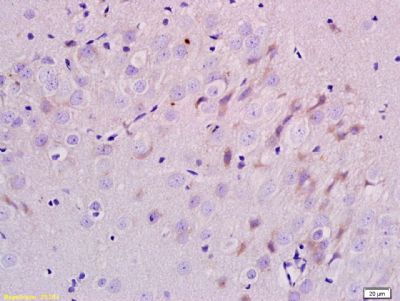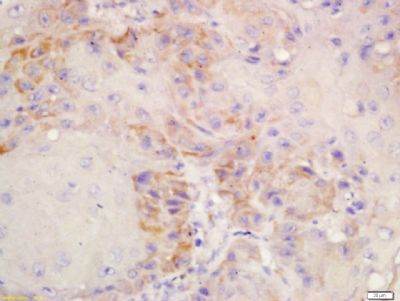产品中心
当前位置:首页>产品中心Anti-ErbB 3
货号: bs-1454R 基本售价: 380.0 元 规格: 20ul
- 规格:20ul
- 价格:380.00元
- 规格:50ul
- 价格:780.00元
- 规格:100ul
- 价格:1380.00元
- 规格:200ul
- 价格:2200.00元
产品信息
- 产品编号
- bs-1454R
- 英文名称
- ErbB 3
- 中文名称
- 表皮生长因子受体3抗体
- 别 名
- ErbB 3; ErbB-3; c erbB 3; c-erbB3; ERBB3; cerbB3; ERBB3 protein; cerbB; 3erbB3 S; Glial growth factor receptor; HER 3; HER3; LCCS2; MDA BF 1; MGC88033; p180 ErbB3; p45 sErbB3; p85 sErbB3; proto-oncogene-; receptor tyrosine protein kinase ERB3 [precursor]; Receptor tyrosine protein kinase erbB 3; Receptor tyrosine protein kinase erbB3; Tyrosine kinase type cell surface receptor HER3; V erb b2 avian erythroblastic leukemia viral oncogene homolog 3; v erb b2 erythroblastic leukemia viral oncogene homolog 3 (avian); v erb b2 erythroblastic leukemia viral oncogene homolog 3; ERBB3_HUMAN.
- 规格价格
- 50ul/780元购买 100ul/1380元购买 200ul/2200元购买 大包装/询价
- 说 明 书
- 50ul 100ul 200ul
- 研究领域
- 肿瘤 免疫学 信号转导 生长因子和激素 激酶和磷酸酶 细胞膜受体 G蛋白偶联受体 肿瘤细胞生物标志物
- 抗体来源
- Rabbit
- 克隆类型
- Polyclonal
- 交叉反应
- Human, Mouse, Rat, Chicken, Dog, Cow, Horse, Rabbit,
- 产品应用
- ELISA=1:500-1000 IHC-P=1:400-800 IHC-F=1:400-800 IF=1:100-500 (石蜡切片需做抗原修复)
not yet tested in other applications.
optimal dilutions/concentrations should be determined by the end user.
- 分 子 量
- 147kDa
- 细胞定位
- 细胞膜 分泌型蛋白
- 性 状
- Lyophilized or Liquid
- 浓 度
- 1mg/ml
- 免 疫 原
- KLH conjugated synthetic peptide derived from the middle of human ErbB-3:661-760/1342 <Cytoplasmic>
- 亚 型
- IgG
- 纯化方法
- affinity purified by Protein A
- 储 存 液
- 0.01M TBS(pH7.4) with 1% BSA, 0.03% Proclin300 and 50% Glycerol.
- 保存条件
- Store at -20 °C for one year. Avoid repeated freeze/thaw cycles. The lyophilized antibody is stable at room temperature for at least one month and for greater than a year when kept at -20°C. When reconstituted in sterile pH 7.4 0.01M PBS or diluent of antibody the antibody is stable for at least two weeks at 2-4 °C.
- PubMed
- PubMed
- 产品介绍
- background:
The ErbB3 gene encodes a member of the epidermal growth factor receptor (EGFR) family of receptor tyrosine kinases. ErbB3 is a membrane-bound protein which has a neuregulin binding domain but not an active kinase domain. It can therefore bind this ligand but cannot convey a signal into the cell via protein phosphorylation. However it does form heterodimers with other EGF receptor family members which do have kinase activity. Heterodimerization leads to the activation of pathways which lead to cell proliferation or differentiation. Amplification of this gene and/or overexpression of its protein have been reported in numerous cancers including prostate, bladder and breast tumors. Alternate transcriptional splice variants encoding different isoforms have been characterized. One isoform lacks the intermembrane region and is secreted outside the cell. This form acts to modulate the activity of the membrane-bound form. Additional splice variants have also been reported but they have not been thoroughly characterized.
Function:
Binds and is activated by neuregulins and NTAK.
Subunit:
Monomer and homodimer. Heterodimer with each of the other ERBB receptors (Potential). Interacts with CSPG5, PA2G4, GRB7 and MUC1.
Subcellular Location:
Isoform 1: Cell membrane; Single-pass type I. membrane protein. Isoform 2: Secreted.
Tissue Specificity:
Epithelial tissues and brain.
Post-translational modifications:
Ligand-binding increases phosphorylation on tyrosine residues and promotes its association with the p85 subunit of phosphatidylinositol 3-kinase. Subject to autophosphorylation.
DISEASE:
Defects in ERBB3 are the cause of lethal congenital contracture syndrome type 2 (LCCS2) [MIM:607598]; also called Israeli Bedouin multiple contracture syndrome type A. LCCS2 is an autosomal recessive neurogenic form of a neonatally lethal arthrogryposis that is associated with atrophy of the anterior horn of the spinal cord. The LCCS2 syndrome is characterized by multiple joint contractures, anterior horn atrophy in the spinal cord, and a unique feature of a markedly distended urinary bladder. The phenotype suggests a spinal cord neuropathic etiology.
Similarity:
Belongs to the protein kinase superfamily. Tyr protein kinase family. EGF receptor subfamily.
Contains 1 protein kinase domain.
SWISS:
P21860
Gene ID:
2065
Database links:Entrez Gene: 2065 Human
Entrez Gene: 29496 Rat
Omim: 190151 Human
SwissProt: P21860 Human
SwissProt: Q62799 Rat
Unigene: 118681 Human
Unigene: 10228 Rat
Important Note:
This product as supplied is intended for research use only, not for use in human, therapeutic or diagnostic applications.
- 产品图片
 Paraformaldehyde-fixed, paraffin embedded (rat brain tissue); Antigen retrieval by boiling in sodium citrate buffer (pH6.0) for 15min; Block endogenous peroxidase by 3% hydrogen peroxide for 20 minutes; Blocking buffer (normal goat serum) at 37°C for 30min; Antibody incubation with (ErbB-3) Polyclonal Antibody, Unconjugated (bs-1454R) at 1:400 overnight at 4°C, followed by a conjugated secondary (sp-0023) for 20 minutes and DAB staining.
Paraformaldehyde-fixed, paraffin embedded (rat brain tissue); Antigen retrieval by boiling in sodium citrate buffer (pH6.0) for 15min; Block endogenous peroxidase by 3% hydrogen peroxide for 20 minutes; Blocking buffer (normal goat serum) at 37°C for 30min; Antibody incubation with (ErbB-3) Polyclonal Antibody, Unconjugated (bs-1454R) at 1:400 overnight at 4°C, followed by a conjugated secondary (sp-0023) for 20 minutes and DAB staining. Tissue/cell: Human laryngeal tissue; 4% Paraformaldehyde-fixed and paraffin-embedded;
Tissue/cell: Human laryngeal tissue; 4% Paraformaldehyde-fixed and paraffin-embedded;
Antigen retrieval: citrate buffer ( 0.01M, pH 6.0 ), Boiling bathing for 15min; Block endogenous peroxidase by 3% Hydrogen peroxide for 30min; Blocking buffer (normal goat serum,C-0005) at 37℃ for 20 min;
Incubation: Anti-ErbB 3 Polyclonal Antibody, Unconjugated(bs-1454R) 1:200, overnight at 4°C, followed by conjugation to the secondary antibody(SP-0023) and DAB(C-0010) staining

